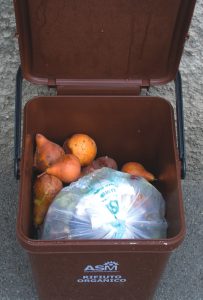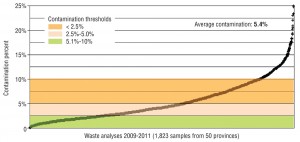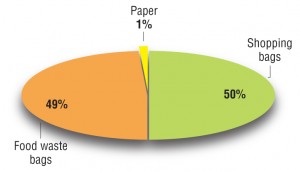Italy’s nationwide ban on plastic shopping bags in 2011 exempts compostable bags, which has in turn benefited organics diversion.
Christian Garaffa and Rhodes Yepsen
BioCycle August 2012, Vol. 53, No. 8, p. 48

Residential source separated organics service is now available to 24 million people in Italy. In 2010, 2.8 million tons of food scraps were collected for composting and anaerobic digestion.
The EU’s main drivers for organic waste diversion include the Waste Framework and Landfill Directives. The revised Waste Framework (Directive 2008/98/EC) requires EU Member States to take measures to encourage separate collection of organic waste for composting and/or anaerobic digestion (AD). More broadly, it mandates that Member States recycle 50 percent of all waste from households by 2020 (C&D debris is not accounted for and must independently reach 70 percent diversion by 2020). The separate but related Landfill Directive (99/31/EC) requires Member States to divert 65 percent of organic waste from landfill by 2016 compared to 1995 landfilling levels in each Member State. All remaining wastes must be pretreated before landfilling to reduce the amount of fugitive emissions. Italy has more stringent legislation that requires separate collection of 65 percent of all municipal solid waste (MSW) by the end of 2012 (D.Lgs 152/2006).
Italy began collecting residential organics in the northern part of the country in the mid-1990s, in response to dwindling landfill space and rising disposal fees. Residential source separated organics (SSO) service is now available to 24 million people, spread out over 2,500 municipalities. Infrastructure has grown to accommodate new diversion programs, as there were only about 10 facilities in 1993. In 2010, 257 industrial composting facilities (120 over 11,000 tons annual processing capacity) and 23 AD facilities treated about 4.4 million tons of organics. Of these, 2.8 million tons were food scraps and 1.7 million tons yard trimmings. Of the food scraps, roughly 2.1 million tons were composted and 700,000 tons were digested.
When talking about residential organics in Italy, an important distinction between food scraps and yard trimmings must be made. Food scraps are collected separately and the curbside collection of yard trimmings is generally not encouraged. Waste prevention policies tend to encourage backyard composting instead.
Capture Rates
Average captures for yard trimmings are about 110 kg/household (240 lbs) where only dropoff systems are in place. If on-demand paid curbside collections are implemented, this value increases to 180 kg/household (397 lbs). In the few municipalities where free curbside collection for yard trimmings exists, the average goes up to 230 kg/household (507 lbs). (Average household is 2.3 inhabitants in Italy.)
For residential food scraps, through a system of intensive SSO (ISSO), the best performing programs in Italy have managed to achieve very high capture rates, ranging between 60 to 100 kg/inhabitant/year (130 to 220 lbs), equaling 140 to 230 kg /household/ year (310 to 510 lbs). This depends partly on the region, as there are different cooking traditions, some using more fresh ingredients and therefore generating more scraps. (Food scraps represent 15 percent of the overall MSW in the northern part of the country and 25 percent in the south!). Currently Italy is capturing an average of 35 percent of the potential target for food scraps. In the northern part of the country this value is 57 percent, whereas in the south it’s still lagging at 18 percent. There are still 4.4 million tons/year to be collected.
The ISSO model has established best practices to maximize organic waste diversion (see “Intensive Source Separated Organics,” April 2010 for a detailed description). Food scraps are collected separately. Several municipalities are strictly controlling the use of only compostable plastic bags certified to the European standard EN13432. Food scraps are typically collected two times a week (collection once a week is now spreading especially in the winter months), whereas trash collection is weekly or less than weekly. Successful ISSO programs are able to capture around 90 percent of available food scraps, leaving less than 10 percent of putrescible waste in the trash. In addition to the appropriate collection frequency, the whole system relies on pay-as-you-throw pricing structures, clear communications and household tools to make participation easy (“free” kitchen pails and compostable bags, are often paid for through the general waste fees).
Contamination Analyses And Bag Legislation
The Italian Composting Council (CIC) routinely performs waste analyses for its members to determine the composition of materials being captured for composting, and help identify causes of contamination. A traditional waste composition analysis released in 2011 determined the types and amounts of noncompostable contaminants. Between 2009 and 2011, CIC conducted 1,823 waste audits in 50 provinces. The results represent a sample of about 20 million people. While the situation varies greatly depending on the province (and practices used in SSO), the average contamination rate is 5.4 percent (Figure 1).Since December 2010, Italy has only allowed compostable bags certified under the EU’s compostability standard (EN13432) to be used in SSO programs (D.Lgs. 152/06 e s.m.i.). Municipalities previously allowing or even promoting use of noncompostable plastic bags to collect organics were required to allow and/or promote only certified compostable bags. This has significantly helped reduce contamination, as the results in the analyses indicate.
In January 2011, Italy enacted the first national ban on “nonbiodegradable” shopping bags in the EU (Legge Finanziaria 2007). However, no reference standard was included in the law, meaning any bag claiming to be biodegradable could be used. By not specifying that bags be certified to EN13432, the law didn’t connect the existing compostability standard to the laws requiring more diversion via SSO programs. In other words, compostable bags are a “tool” to meet organic diversion requirements. This was corrected in January 2012, with specific reference to the standard (D.L.25 gennaio 2012, n. 2).
Overall in Italy, about half of the bags used in SSO are certified compostable. In some areas the quality of the feedstock is very high with contamination rates around one percent; in other regions and municipalities, noncompostable plastic bags are the most used collection tool with contamination problems at the composting facilities and huge amounts of residues being sent from there to disposal. CIC also conducted a comparative analysis between the contents of compostable versus noncompostable bags. In 2011, 54 analyses were done in 12 provinces. The average contamination found in compostable bags was 1.13 percent, whereas the contamination found in plastic bags was 5.06 percent, not considering the bag. When the plastic bag was included, it was 7.05 percent. This shows a clearly different attitude and behavior by people educated about using certified compostable bags versus those allowed to use any kind of plastic bag. In Italy this is called the “drag effect.”
Focusing on those municipalities where compostable bags are extensively used for SSO, the shopping bags (purchased at check out for 10 eurocents) have already gained a considerable share (50 percent), proving to be a valuable collection tool for citizens. Figure 2 illustrates this shift; food waste bags sold in boxes in the stores represent 49 percent, and paper has a 1 percent share. Having all the major retailers now switched to certified compostable shopping bags — including those in those areas where noncompostable plastic bags are massively used — is having a very significant effect on the composition of the bags used for collecting the food scraps.
The updated law also provided a definition of a single-use shopping bag depending on thickness, presence of handles and type of store (food or nonfood), in order to determine what bags were truly reusable. The law imposes fines for offenders not meeting the reusable definition (be it manufacturers, resellers, retailers) from 2,500 to 25,000 Euros ($3,070-$30,697 USD), but fines won’t come into effect until the end of 2013. Some communities are anticipating earlier enforcement at the local level, especially where ISSO is already in place and the value of certified compostable shopping bags is fully understood.
Christian Garaffa is Marketing Manager, Source Separation and Recycling, for Novamont, SpA, and works with European composting associations and waste consulting companies managing projects with local authorities, private and public waste management companies, retailers and other stakeholders (christian.garaffa@novamont.com). Rhodes Yepsen is Marketing Manager for Novamont North America, Inc. (rhodes.yepsen@novamont.com). The authors thank the Italian Composting Council and the consulting company ARS Ambiente for providing most of the data reported in the article.












